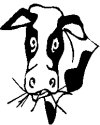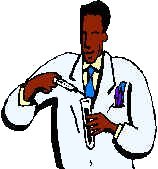

To send a message to an author, click on the author's name at the end of the article.
This Month in Ag Connection | Ag Connection - Other Issues Online

(Source: John Hall, Extension Animal Scientist, Virginia Tech.)
This Month in Ag Connection | Ag Connection - Other Issues Online
A. Implants:
Average daily gain response of approximately 0.1 pound per day can be expected for
suckling steer calves from zeranol (Ralgro ®) and estradiol-progesterone (Synovex ® and
its generics) implants. Gain response in suckling heifers is slightly greater (0.12 to
0.14 pounds per day). A summary of research trials involving four different
implants and over 3,900 suckling calves found that the average improvement in weaning
weight over non-implanted calves was 18.5 pounds. There are no negative consequences of
implanting suckling calves that are intended for slaughter on health, subsequent growth,
and carcass value. Replacement heifers should not be implanted if they can be identified
at an early age. Suckling heifers that are implanted one time at about 45 days of age are
usually similar in reproductive performance to non-implanted heifers. The greatest
decrease in fertility occurs when heifers are implanted near birth, or more than one time.
Cost: The value of gain for suckling calves is assumed to be $55 per hundred pounds. This value has remained constant for a number of years and is determined by comparing how much more the market is willing to pay for a 500 pound steer compared to a 400 pound steer of the same quality. Using the 18.5 pound advantage (average of steer and heifer gain advantage), the cost of not implanting is: 18.5 x $0.55 = a $10.18 loss per calf .
A 500-lb. calf would need to bring an additional $2.03/cwt to equal the income of the implanted calf.
B. Feed Additives:
Ionophores: Metabolizable and net energy values of feeds should increase when ionophores are consumed. It is recommended that when balancing a ration, the NEm provided by the diet be increased by 12% if ionophores are included. Ionophore use in conjunction with high roughage diets (pasture, hay or silage) results in the same consumption but increased rate of gain because of improved efficiency of feed utilization.
Now cleared for use in replacement heifers, inclusion of ionophores in heifer diets has been shown to increase the number of heifers that had reached puberty by the start of the breeding season, decrease the age at puberty, decrease the weight at puberty, increase the corpora luteal weight, and increase the amount of progesterone produced. The decrease in age at puberty was independent of improved average daily gain and increased body weight. Moseley et al. (1982) speculate that changes in ruminal fermentation patterns to favor proprionic acid production produce an endocrine response which influences the mechanisms regulating puberty.
Cost: The cost of not feeding ionophores to cows on pasture depends on forage quality and quantity. Ionophores probably offer little advantage to mature cows grazing high-quality pasture in abundant supply. The cost of not feeding ionophores to replacement heifers will be similar to that of stocker cattle.
A. Implants:
Typically, anabolic implants increase cattle weight gains by 8 to 18% (or 15 to 40 lbs.
during the grazing season). Stocker steers appear somewhat more responsive to
implants than heifers. A summary of 43 University of Missouri field studies involving
3,068 steers by Sewell (1990) found that stockers implanted with Ralgro grew 14.6% faster,
resulting in 22 lbs. more gain per steer over 125 days than controls. The gain
responses obtained from implanting grazing steers and heifers are related to the basal
growth rate as affected by forage quality or quantity, and associated nutritional
limitations. Numerous trials show this effect by the fact that improvements in implanted
stockers compared to controls were greatest when the grazing controls had good gains.
This is consistent with practical recommendations that stockers should gain at least
0.7 to 1.0 lbs. daily in order to obtain a reasonable response from implanting. And,
although little or no response should be expected from implants when stocker gains are
limited due to poor pasture or environmental conditions, no adverse effects have been
demonstrated.
Specific implants have been shown to be beneficial in minimizing the detrimental effects on stocker gains of the fungal endophyte Acremonium coenophialum which infects most of the tall fescue pastures in the United States. Brazle and Coffee (1991) were able to show improvement in fall stocker daily gains on both low-endophyte (12 to 16% improvement) and high-endophyte (37 to 46% improvement) fescue pastures. Whether other implants have a similar effect has not been investigated adequately.
As with implanting suckling calves, no detrimental effects of implanting stockers has been found on feedlot or carcass performance. The added daily gain from implanting during the stocker phase is maintained through the finishing period, and no differences in carcass traits were found.
Cost: The value of gain for stocker cattle is similar to the value of gain for suckling calves ($55/cwt). Using a 23 pound advantage in weight for implanted calves, the cost of not implanting is: 23 x $0.55 = a $12.65 loss per calf even though the implanted cattle were assumed to sell for less per hundred weight because of their greater weight.
A 700-lbs calf would need to bring an additional $1.80/cwt to equal the income of the implanted calf.
B. Feed Additives:
Ionophores: In one trial, monensin added to the mineral mix of cattle grazing native grass improved gain by 7.7% (0.19 lb/head/day; P<0.05) and the steers consumed 32% less mineral (3.4 oz vs. 5.0 oz./head/day; P<0.03) compared to controls. In numerous trials utilizing both heifers and steers and grazing various forage types (native grass, Berudagrass, fescue, crop residue, winter wheat) fed a small amount of supplement (1-2 lbs. daily) with or without ionophores, average daily gain was improved 8-45% (0.12-0.22 lbs./day) with ionophores.
In addition to their effects on gain and efficiency, ionophore supplementation is effective for the prevention of acute bovine pulmonary emphysema and edema (ABPEE) and bloat when cattle graze lush pasture. If the ionophore is hand-fed (rather than fed free-choice), it will help prevent and control coccidiosis. Ionophores also impact mineral utilization. In general, ionophores enhance absorption of nitrogen, magnesium, phosphorus, zinc, and selenium with inconsistent effects on calcium, potassium and sodium.
Antibiotics: Both oxytetracycline and chlortetracycline are approved for improved feed efficiency, increased rate of gain, and reduction of liver abscess in growing cattle. In addition, chlortetracycline is approved for control of anaplasmosis. Published research that quantifies the improvement in feed efficiency and increased gain in grazing animals is lacking. It is assumed that improvement of average daily gain is similar to that found with ionophore antibiotics (i.e. 15%, range = 8-45%).
Cost: The value of gain for stocker cattle is historically $55/cwt. Using a 15% advantage in weight gain for calves fed ionophores (30 pounds in 100 day grazing period), the cost of not using ionophores is: 30 x $0.55 = a $16.50 loss per calf minus the cost of the ionophore ($0.50) = net $16.00 loss even though the cattle fed ionophore were assumed to sell for less per hundred weight because of their greater weight.
A 700-lbs calf would need to bring an additional $2.36/cwt to equal the income of a calf fed ionophores.
(Author: Bob L. Larson, DVM, PhD, ACT)
This Month in Ag Connection | Ag Connection - Other Issues Online

University of Missouri Soil Scientists released information concerning a new nitrogen test available. The new tool, the preplant nitrogen test, will be used to improve nitrogen recommendations for corn and grain sorghum. Soil samples (to two feet) are taken before planting and the results are used to adjust spring fertilizer nitrogen rates. The new nitrogen test can also be used to adjust spring fertilizer rates for wheat.
The test is a product of research Peter Scharf and John Lory have done the past 5 years on farmers’ corn fields across the state.
Important points about the new nitrogen test and recommendation:
1. It is only recommended when there is an expectation of high amounts of residual inorganic nitrogen in the Spring soil profile.
Examples include:
2. The test requires sampling the soils to a depth of 2 feet.
3. Samples must be sent to the lab for testing within 24 hours or be air-dried or frozen before submission to the lab.
UMC Guide 9177, Preplant Nitrogen Test for Adjusting Corn Nitrogen Recommendations is available at your local University Outreach and Extension Center or click here to find it on the World Wide Web. It has the details of how to take the sample, interpreting the results and much more.
This Month in Ag Connection | Ag Connection - Other Issues Online
Publishing Information
Ag Connection is published monthly for Northeast and Central areas of Missouri producers and is supported by the University of Missouri Extension, the Missouri Agricultural Experiment Station, and the MU College of Agriculture, Food and Natural Resources. Managing Editor: Mary Sobba.